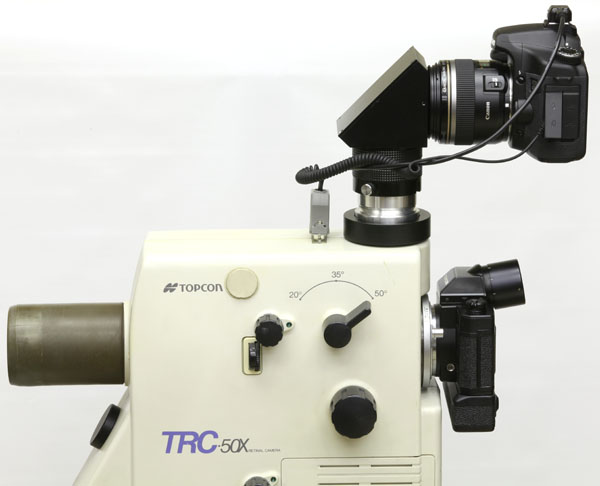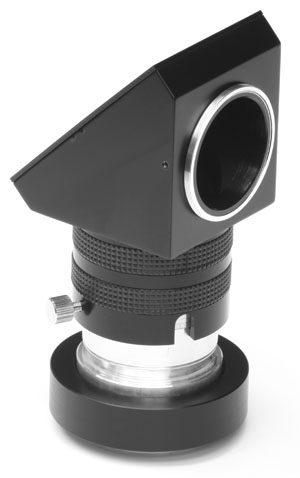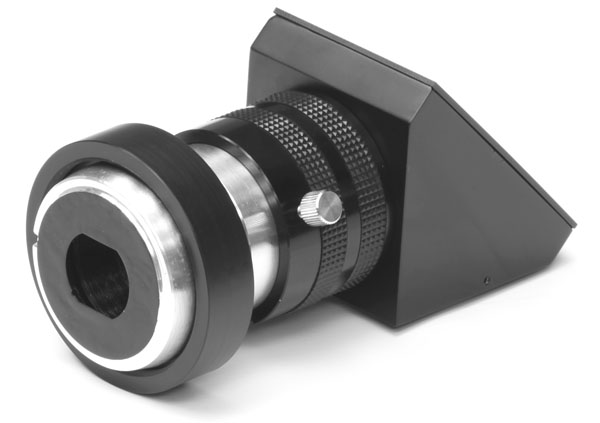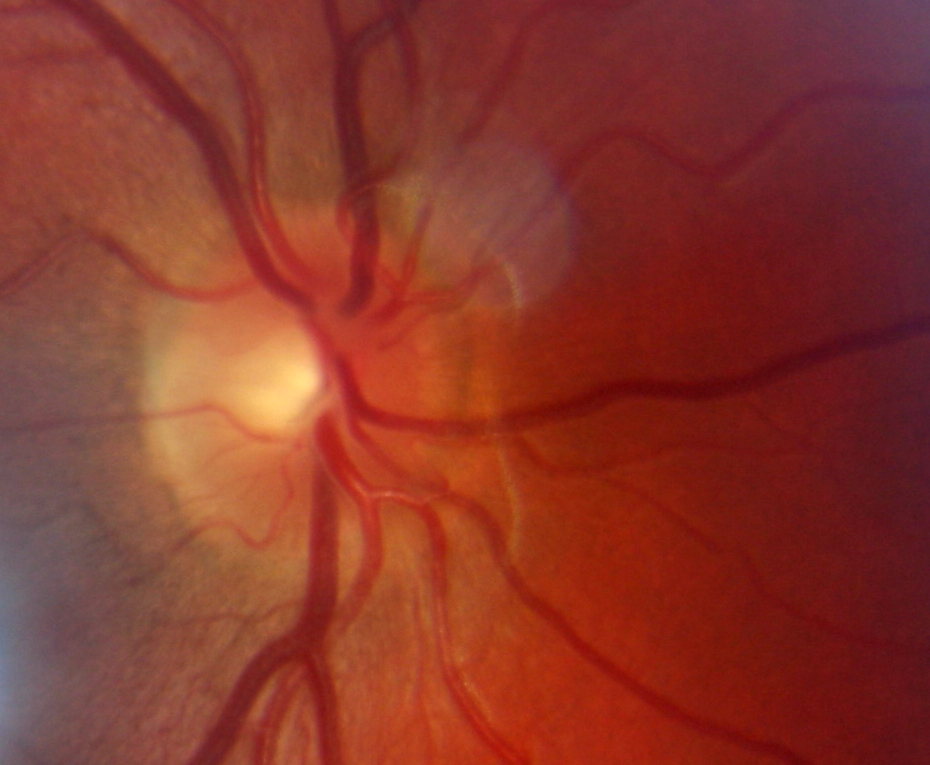INSTALLING AND OPERATING THE
TOPCON TRC-50X UPPER PORT DIAGONAL
DIGITAL CAMERA UPGRADE KIT
Richard J Kinch
http://www.truetex.com
November, 2011
This document describes how to install and operate
the digital camera upgrade kit for the upper port of the
Topcon TRC-50X retinal camera.
Identify the upgrade kit contents:
- Custom optical adapter assembly (see Figure 2 below) consisting of:
- Mirror diagonal
- 52mm threaded lens fitting
- Bayonet fitting for Topcon TRC-50X upper port
- 1.3mm hex key for fastening setscrews in diagonal
- Electronic interface cable, DB-15 male plug to camera remote connector (Canon E3 plug) and camera hot-shoe male.
- Optional E3-N3 remote connector adapter, if you are using a Canon digital camera model other than a Rebel type.
- Upper-port mirror-switch kit with separate printed instructions for installation.
If you previously submitted your TRC-50X upper unit to us, this kit will already have been installed into your Topcon system, and the
instructions are for your reference only.
- These printed instructions.
Other components you must obtain separately:
- Canon EOS digital SLR camera. Any Canon EF-S lens-mount model is compatible with the Topcon adapter,
including the Digital Rebel series
(such as the Canon T2i) (Buy Now)
and the 60D and 7D models. Costlier full-frame models such as the
Canon 5D Mark II are not compatible with the required 60mm EF-S lens.
- Canon EF-S 60mm f/2.8 Compact Macro USM AutoFocus Lens (Buy Now). This is the only stock lens mechanically and optically compatible with the adapter.
- Memory card(s) for the camera.
- AC power supply for the camera (if you wish not to depend on battery power).
The adapter kit works by design with ordinary, standard Canon retail camera bodies and lenses,
and with the constantly improving standard computer software supporting digital photography.
No special version or modifications of hardware or software are required.
New Canon camera models in the future should also be compatible, as should
advances in Canon and third-party computer software support.
You may process the standard RAW or JPEG images using industry standard software such as Adobe
Photoshop or Corel PhotoPaint.
Optional components you may wish to obtain separately:
- Computer and software for post-processing and viewing digital photos.
- Computer and software for live PC preview as you photograph ("tethering").
Canon includes software for this purpose with their digital SLR cameras, or you may wish
to use a studio photography application such as DSLR Remote Pro
(http://www.breezesys.com/DSLRRemotePro/).
- An enhanced memory card providing wireless networking for instant transfer of photos
to your network storage server as you shoot.
Familiarize yourself with the digital camera and lens:
If the digital SLR camera is new to you, study at least the following features which
will be used for retinal photography: On/off switch, mode switch "M" setting for manual operation, setting manual exposure time,
attaching and removing lenses, remote shutter release connector,
hot shoe, viewing photos on the camera, transferring photos to a computer.
Also read the instruction manual for the Canon 60mm lens to learn about the following
features of the lens: filter mounting thread, focusing ring, focus mode switch, and distance scale.
You must understand these features to apply the manual focus calibration procedure below, which is
mandatory for proper operation of the adapter.
Install the upper-port mirror switch:
This installation step is covered in a
separate instruction document,
a printed copy of which is included with the adapter.
Retain the original Topcon 35mm film camera and viewfinder:
The original Topcon 35mm film camera viewfinder remains the viewfinder for use with the digital photography
system. Only the viewfinder is used for digital photography, so the 35mm film camera does not need 35mm
film loaded, or even to be a working camera body other than the viewfinder portion.
Choose an adapter orientation:
The adapter normally orients to the rear, such that the camera is above the operator's head.
The adapter is supplied already configured into this orientation.
This makes the digital camera conveniently accessible, but the close location to the operator's
head may be inconvenient.
If so, you may optionally re-orient the adapter on the upper port in two alternative ways, "forward" or "right-hand".
Re-orient the adapter by (1) loosening the thumbscrew on the Topcon fitting of the diagonal
to swing the adapter around, and (2) loosening the setscrews on the digital camera lens fitting to turn the
camera for upright images.
The "forward" orientation places the digital camera inverted and directly over the top of the Topcon upper unit.
This is the most compact orientation, but does not allow convenient access to the digital SLR camera body.
Instead, the camera body is also located in away from the operator, making it awkward to review photos on the
camera display, and practically requiring an external HDTV display or tethered PC.
The "right-hand" orientation places the camera out to the right of the upper port,
with the top of the camera body facing the operator.
The camera is somewhat more accessible to the operator (although still on its side),
but the camera is somewhat awkwardly suspended over the side of the Topcon upper unit.
Attach the Canon lens to the adapter:
Observe that the adapter provides a Topcon upper-port bayonet fitting, and a 52mm threaded lens fitting.
Take care especially with the Topcon fitting, since the aperture is thin and fragile.
Observe that one thumbscrew locks the Topcon fitting into the diagonal, and three setscrews lock the lens fitting into the diagonal
using the supplied 1.3mm hex key.
See Figure 2 and Figure 3 below.
Each fitting rotates when the screw(s) are loosened. Adjusting this rotation is
a part of assembling the lens and installing the adapter on the upper port.
By carefully adjusting the rotation and locking the adjustment with the thumbscrew and setscrews,
you perform several critical adjustments: the rear, forward, or right-hand orientation
of the adapter, the alignment of the adapter squarely to the instrument, and the alignment of the camera squarely
to the image.
The side faces of the diagonal show one setscrew each, and the end face
one setscrew.
To attach the digital camera to the adapter, first screw the Canon 60mm lens to the threaded end of the diagonal.
Tighten this snugly but not so much as to damage the fine threads.
Attach the digital SLR camera body to the lens.
Most likely this will not leave the camera body level, so loosen the setscrews and adjust
the rotation of the camera body so the camera is level (or inverted or to the rear if you are using one of the
alternate orientations).
Tighten the setscrews to lock the orientation.
Calibrate the focus of the Canon camera to the Topcon instrument:
Focus calibration is a quick and easy, one-time procedure, but it is absolutely critical to the proper
performance of the adapter.
You must set the digital camera lens to a fixed, manual focus on the adapter's field stop, which
permits you later to focus the retinal image in the normal way.
If the focus calibration is off, then all digital photos will be out of focus even though the instrument
display indicates a correct focus on the patient eye. Proceed as follows:
-
If you have perhaps already attached
the adapter and camera to the Topcon instrument, remove them
from the Topcon instrument by releasing the bayonet lock lever on the
Topcon upper port.
-
Look into the Canon camera viewfinder. Turn the Canon viewfinder diopter adjustment wheel so that you see the focusing squares in the
Canon viewfinder clearly (see "dioptric adjustment" topic in the Canon camera Instruction Manual).
-
Push the AF/MF (automatic/manual) focus mode switch on the Canon 60mm lens to the MF (manual focus) position.
Always leave this switch in the MF (manual focus) position when you are using the camera on the Topcon adapter.
-
Look into the Canon viewfinder while you point the open end of the adapter towards a bright, diffuse
light source such as a well-lit white wall. Turn the manual focus ring on the Canon 60mm lens and observe
the adapter's circular field stop come in and out of sharp focus.
-
Adjust the focusing ring so the edge of the field stop is
in sharpest possible focus. This is the proper focus calibration when the adapter tube is fully inserted and
locked on the lens sleeve.
-
Semi-permanently lock the focus ring by applying a piece of Scotch tape or a snip of self-adhesive paper label across
the lens body next to the focus ring. This keeps the manual focus locked on the calibration you have just set.
-
Check the focus in the viewfinder, now locked with the bit of tape you applied, to make sure that the
field stop aperture is still sharply in focus. If you inadvertently moved the focusing ring while applying
the tape, remove the tape and repeat the focus calibration and tape-locking.
-
The clarity of all subsequent digital retinal photos depend on a proper manual lens focus calibration.
Once the focus calibration is properly set and locked, you should not have to perform the calibration again.
If you find your retinal photos are consistently out of focus, yet you are sure your technique with the
Topcon instrument and its focus are correct, check the Canon lens focus calibration and recalibrate if needed.
-
You may remove the Canon camera and/or lens from the Topcon adapter to use them for ordinary photography,
but you must repeat this manual focus calibration and tape-locking if you remove the tape from the lens
and lose the Topcon focus calibration.
-
It is normal for a bit of sag from the weight of the camera on the Canon lens to move the apparent image
slightly towards the bottom of the viewfinder. This should not result in any of the Topcon image area being cropped from
the edge of the digital frame.
-
Besides rotating, the Topcon fitting can be adjusted in and out of the diagonal by loosening the thumbscrew.
Use this in-out adjustment to provide more clearance for the operator's head when the adapter is oriented in the normal
direction (that is, to the rear).
Use the inmost adjustment which just prevents the camera from bumping the top of the operator's head.
Do not adjust the fitting out so much that the thumbscrew clamp does not fully engage the fitting.
Any in-out adjustment of the Topcon fitting will also slighly enlarge (in) or shrink (out) the cropping of the retinal image in
the digital image frame. This adjustment will also require recalibrating the focus as described above.
Alternative focus calibration methods:
You may also calibrate the adapter focus by focusing an image in the instrument and then focusing the digital
camera to the same image, as follows. Set up a distant focusing target in the center of the instrument view,
such as a small, bright light across the room or down a hallway.
A distant, luminous, pinpoint test target will greatly simplify the focusing image and improve the accuracy
of the calibration. A lighted ophthalmoscope, transillumination lamp, or penlight are excellent for this purpose.
Perform this procedure with the Topcon power off.
Focus on the test target with the Topcon viewfinder (use the "+" diopter compensation lens
setting on the instrument to focus on the near-infinity object).
Take care to compensate for any refraction error in your observing eye by rotating diopter correction in the
viewfinder eyepiece, so that the viewfinder crosshairs appear in sharp focus.
Once the test target is focused using the Topcon viewfinder,
flip the upper-port mirror in the Topcon TRC-50X upper unit selecting the TV mode on the TRC-50X console.
This should redirect the image to the upper port, so you can
now see the same image in the digital camera's live view or viewfinder, being
careful not to alter the Topcon focus knob or carriage position. While watching the Canon live view or viewfinder image, focus
the Canon lens in the Canon viewfinder and lock this focus with a sticker on the lens.
The live view feature, if available on your Canon camera model, will allow you to focus perfectly and more accurately than with the viewfinder,
by using the 10X live view magnification.
If you don't have the live view feature, you can still
take test photos on the digital camera and enlarge them on the digital camera display, to set the
focus accurately by trial and error.
Connect the electronic interface cable between the base of the Topcon instrument and the digital camera:
Insert the 15-pin plug of the cable into the receptacle on the top of the the Topcon upper unit, near the upper port.
Attach the digital camera with adapter to the Topcon instrument:
Observe that the Topcon upper port provides a vertical pin which must engage a slot in the adapter fitting.
Attach the adapter to the upper port of the Topcon instrument in the usual way.
That is, mate the adapter to the upper-port receptacle, locating the adapter fitting's slot over the Topcon pin.
Insert the adapter fitting fully into the Topcon upper port, carefully engage the threaded lockring, and turn the locking snug by hand.
Tighten the locking only hand-tight.
Connect the two camera-end connectors to the camera, namely (1) the hot-shoe connector to the flash hot shoe,
and (2) the remote-shutter connector to the remote connector on the left side of the digital camera body.
Configure the Canon camera for retinal photography:
- Use a fully-charged battery or external AC power supply.
- Power switch: ON
- Mode dial: M (manual)
- Exposure time: 1/6 SEC.
A shorter exposure time may miss the Topcon flash. A longer time may smear the image.
- ISO speed: ISO 100 (or ISO 64 or other lower speed, if available on your camera model)
- Aperture: F2.8.
This is the largest aperture setting the lens provides. Setting a smaller aperture
(that is, a larger f/number) will decrease brightness of the image, which may be desirable if the
minimum Topcon flash energy setting yields overexposed photos.
- Memory card inserted
- Connect and start the computer and tethering software if so equipped
Configure the Topcon instrument for digital photography:
- Flash energy: 18 watt-seconds (or as needed for proper exposure).
- Port UPPER/LOWER selection button: UPPER.
- Upper port camera type rotary switch: 35mm.
Adjust the instrument for a fixed test subject:
Tape a business card or other flat, high-contrast, detailed subject to the patient headrest to serve as a fixed test target.
A long strip of clear packing tape stuck across the headrest poles at the canthus marks will serve well.
Stick the tape to the operator's side of the poles, and stick the card
slightly to one side, roughly offset to where a patient eye would be position.
Frame and focus a view of this target using
the Topcon viewfinder in the normal fashion, perhaps pulling away from the subject and
using the "+" diopter compensation lens, as for anterior segment views.
Take test subject exposures:
Focus and align on the test subject using the viewfinder in the usual way.
Press the joystick button to trigger an exposure.
At the moment of exposure, listen for the Canon camera mirror flip and shutter mechanisms operating,
along with the Topcon mirror mechanism flipping.
Observe the light of the retinal camera flash on the subject.
Immediately after the exposure, the Canon camera should momentarily display a view of the image on the
camera display.
Review test subject exposures:
If you are using a tethered PC to capture photos, refer to the tethering software user manual for
image review.
If you are using the stand-alone camera to shoot onto the camera's memory card (with no tethered PC),
use the Canon menu buttons to manually review exposures on the camera display.
You may lengthen the automatic review time with the "Review time" menu setting on the digital camera.
Zoom in when reviewing images to verify that the captured image appears sharply in focus when the video viewfinder also appeared in focus.
Note that the full resolution of the digital camera is much finer than the instrument resolution, so
the highest-resolution images will not appear in focus when zoomed in completely.
Take live subject exposures:
It is most convenient to obtain a cooperative colleague or patient for your first live retinal digital image tests.
Collimate and focus on the retina in the usual way with the video display, using the joystick button
to take exposures. Check the images for exposure brightness and adjust the Topcon flash energy to
compensate.
Analyze exposures for optimal exposure:
Viewing the image exposure histogram in the digital camera is the only sure way to
evaluate a proper exposure.
The histogram provides a quantitative analysis of your retinal images for
proper exposure level and degree of contrast.
The goal is to have a histogram spread roughly in the middle third of the
dynamic range.
For color retinal photography,
observe the green histogram rather than the white, since for a retinal image most of the
diagnostic information is represented in the green portion of the color spectrum.
The position of the hump in the histogram indicates the exposure level, which should
be around the middle of the range, and the width of the hump indicates the contrast.
If the histograms indicate an exposure off to one end or the other of the camera's dynamic range,
you may shift the exposure range by switching to smaller aperture (that is, a larger f/number) for the Canon 60mm lens.
Correcting exposures and improving contrast with digital post-processing:
Simple post-processing of your digital images on a computer will correct many mis-exposures and
improve correct exposures. Retinal images are by nature limited in contrast, and by digitally
stretching the contrast, the visual impression of the photographic is much improved.
Filtering enhancements such as red-free images are available via digital post-processing, even though
the original instrument may lack the physical filters.
Establish your practice routine:
After completing the above, you will have a powerful digital facility for retinal photography.
You must now handle digital data where you used to handle 35mm film slides or Polaroid prints.
It most regards the digital methods are quicker, easier, and cheaper than film, but do require
an initial investment in careful design and training. Your digital system is based on standard digital cameras, and so is
compatible with ordinary software for capturing, post-processing, and cataloging digital photographs.
Your upgraded digital retinal camera should, with occasional maintenance, provide decades of
reliable service.
Further Notes
Relative exposure factors for film versus digital cameras:
You should understand the relative exposure intensity of the digital camera versus the
35mm film formerly used.
The digital SLR sensor frame is smaller than the area of the original 35mm film frame by a factor of 1:2.6,
and consequently the same flash energy yields 2.6 times more light intensity on the sensor.
Thus 2.6 times less flash energy will produce an equivalent exposure to ISO 100 35mm film when
shooting with a ISO 100 digital camera sensitivity setting.
Thus where one have used, say, 50 watt-seconds for an exposure, now one would use 50/2.6 = 19 watt-seconds
(or 18 watt-seconds being the closest available setting).
The retinal reflex typically yields an exposure histogram of only 25 percent
of the digital dynamic range, so fortunately there is enough room to compensate for over- or under-exposures,
if you are willing to apply digital post-processing to improve the display characteristics.
The instrument is effectively a manual lens:
The Topcon instrument in effect becomes a manual lens for the digital camera.
The Canon lens is set at a fixed focus and acts only as a relay lens.
Camera modes such as aperture priority (Av) and shutter priority (Tv) are
unavailable, since these factors are controlled outside the digital camera.
Using an AC adapter on the Canon camera:
To avoid having to worry about having a charged Canon camera battery, you
may wish to purchase the Canon optional item that powers the camera from
an AC adapter.
Lowering resolution on the camera:
Since the highest resolution images of the camera are finer than the optical resolution
of the instrument, you may wish to set the camera to record lower-resolution images.
This will decrease storage space and improve tethered transfer times.
These settings are found on the camera's "Quality" menu.
Cleaning the adapter optics:
A small amount of dust on either the field lens inside the Topcon fitting of the adapter, or the Canon lens,
should not appear as a repeating artifact on photos, so cleaning should not normally be necessary once the
adapter and digital camera are assembled to the Topcon instrument.
For field lens cleaning,
the retaining ring holding the field lens element in the upper-port
fitting may be unscrewed by inserting a small jeweler's screwdriver into
the spanner wrench holes. Remove this element, clean it, and return it
carefully into the upper-port fitting and secure the retaining ring.
An arrow marked on the side the glass element indicates the direction of light from the Tocpon instrument to the digital,
to help you if you lose the proper orientation of the lens.
Note that the field mask in the adapter is very thin and exposed metal, and will be
easily damaged if mishandled.
Use caution if you remove dust with a canned-air duster.
These may spit bits of liquid refrigerant which will "frost bite" the lens coating
and cause a permanent spot. If you use a canned duster,
hold the can down on a table top to steady it, and move the item being cleaned in front
of the nozzle, instead of moving the can and possibly swishing the liquid up to the dispenser valve.
Tethering software:
If you want to have live previewing and capture of photos on a computer while shooting
with the Canon camera, consider using "tethering" software.
This type of application uses a "tether" from the camera to the computer via a USB cable.
A Canon version is included free with the Canon camera software support disc.
DSLR Remote Pro (http://www.breezesys.com/DSLRRemotePro/)
is one popular aftermarket package sold for this application.
Tethering to a computer with a large display is the best way to instantly
review your photos for proper focus and exposure while you still have a chance to retake
a missed shot.
The small display on the camera does not adequately reveal the quality of the image focus.

Figure 1. Topcon TRC-50X upper unit with upper-port diagonal adapter for Canon digital SLR camera.
This shows the normal (rearward) orientation of the adapter,
so the display and controls of the digital camera face the operator.
You may optionally orient the adapter and digital camera
to the front over the top of the Topcon upper unit,
or to the right side.
Two cables connect the Topcon system to the camera shutter remote and flash sync.
Optional cabling (not shown) provides AC power and PC tethering.
Original Topcon 35mm film camera is retained on the rear port for viewfinding.

Figure 2. Topcon TRC-50X upper-port diagonal adapter for Canon digital SLR camera (showing lens end).
This is the upright orientation of the adapter on the Topcon system.
The diagonal portion is at the top, with the threaded lens attachment facing to the right.
On the bottom is the Topcon upper-port fitting with lockring.
The middle portion shows the thumbscrew and clamping tube which slides over the Topcon fitting.

Figure 3. Topcon TRC-50X upper-port diagonal adapter for Canon digital SLR camera (showing Topcon end).
This view shows adapter fitting and lockring which connect to the Topcon upper port.
Note notch on the left side of the fitting which engages the projecting pin the Topcon receptacle.

Figure 4. Topcon TRC-50X digital adapter sample photo.
This is an enlargement of the optic nerve area from a 50-degree angle shot,
showing the quality and detail available from digital photography.
See higher-resolution original photo.
Copyright 2007, 2008, 2009, 2010, 2011 Richard J Kinch.



